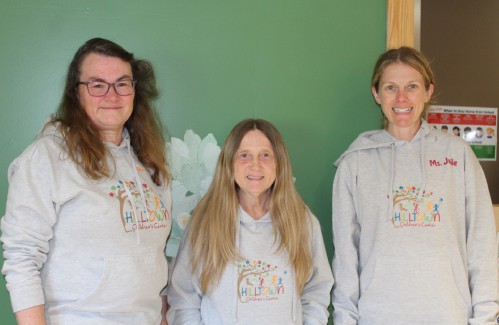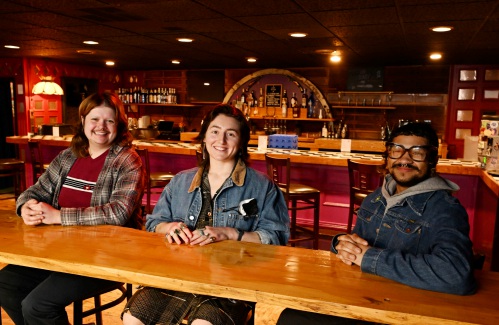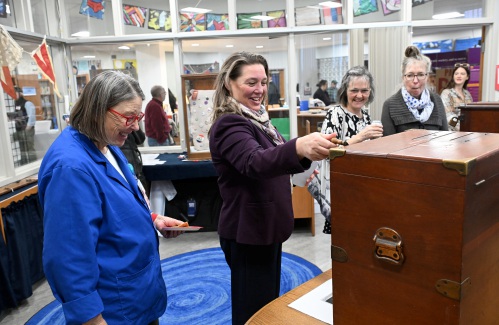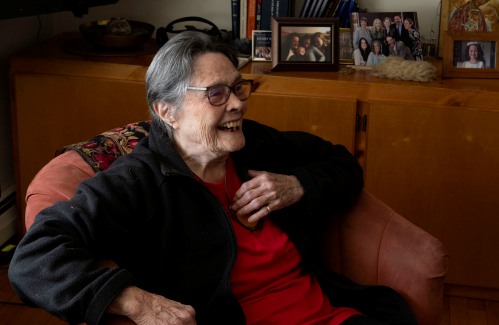
Latest News
 My Turn: This is not who we are
My Turn: This is not who we are
 Real Estate Transactions: May 2, 2025
Real Estate Transactions: May 2, 2025

PHOTOS: Greenfield swears in new deputy fire chief, firefighters

$200K grant fuels expansion at Radial Dynamics in Greenfield
GREENFIELD — Radial Dynamics, a Greenfield hydraulic engineering company, will steer its way into the future with its new high-tech manufacturing equipment, including a robotic arm that was purchased with the help of a $200,000 grant.
Most Read
 Northfield man dies in Erving motorcycle crash; Bernardston man injured in Deerfield crash
Northfield man dies in Erving motorcycle crash; Bernardston man injured in Deerfield crash
 Extension cord under hay ‘being considered a potential factor’ in Leverett house fire
Extension cord under hay ‘being considered a potential factor’ in Leverett house fire
 HS Roundup: Frontier boys, girls track earn wins over Mohawk Trail (PHOTOS)
HS Roundup: Frontier boys, girls track earn wins over Mohawk Trail (PHOTOS)
 Lesbian bar opens in Greenfield: Last Ditch is the new space for the Valley’s queer community
Lesbian bar opens in Greenfield: Last Ditch is the new space for the Valley’s queer community
 Montague seeks alternative demolition design for Strathmore buildings
Montague seeks alternative demolition design for Strathmore buildings
 New Salem town coordinator stepping down
New Salem town coordinator stepping down
Editors Picks
 Business Briefs: May 2, 2025
Business Briefs: May 2, 2025
 Greenfield High School Honor Roll, Third Quarter
Greenfield High School Honor Roll, Third Quarter
 PHOTOS: Busy like bees
PHOTOS: Busy like bees
 Montague, Gill and Erving Notebook: May 2, 2025
Montague, Gill and Erving Notebook: May 2, 2025
Sports

HS Roundup: Pioneer baseball moves to 11-0 following 6-4 win over Frontier (PHOTOS)
SOUTH DEERFIELD — Make it 11 wins in a row to open the season for the Pioneer baseball team.
 Bulletin Board: Greenfield Post 81 holding registration and tryouts Saturday and Sunday
Bulletin Board: Greenfield Post 81 holding registration and tryouts Saturday and Sunday
 HS Notebook: Taking a look at the first spring power rankings
HS Notebook: Taking a look at the first spring power rankings
Opinion

Ed Gregory: Industry away
I do believe emperor Donald Trump failed to factor in a couple of significant dynamics into his delusion of having sizeable industry return to the good ‘ole U.S. of A. I give you robotics and unions. Heavy manufacturing in our technical world incorporates industrial robots to do jobs that a great deal of humans once performed, and, new jobs are being roboticized daily. For those areas that may require people, unions will most likely be a component in the workplace.
 Christine Heard: Love the semicolon
Christine Heard: Love the semicolon
 Kim Wolfram: Wolfram brings a legacy of service to Deerfield
Kim Wolfram: Wolfram brings a legacy of service to Deerfield
 Holly Lankowski: Wolfram has a plan
Holly Lankowski: Wolfram has a plan
 Ava Gips: Examining Wolfram record
Ava Gips: Examining Wolfram record

Your Daily Puzzles

An approachable redesign to a classic. Explore our "hints."

A quick daily flip. Finally, someone cracked the code on digital jigsaw puzzles.

Chess but with chaos: Every day is a unique, wacky board.

Word search but as a strategy game. Clearing the board feels really good.

Align the letters in just the right way to spell a word. And then more words.
Business

As Shady Glen Diner awaits buyer, current owner extends hours, shores up staffing
TURNERS FALLS — Last June, the Shady Glen Diner at 7 Avenue A was put up for sale. Nine months later, a buyer still has not been found, but owner Charles Garbiel has extended the diner’s hours and expects to play the long game.
 Expanding child care options: Hilltown Children’s Center opens in Shelburne
Expanding child care options: Hilltown Children’s Center opens in Shelburne
 Cooking up an expansion: Cocina Lupita eyes second location in Turners Falls
Cooking up an expansion: Cocina Lupita eyes second location in Turners Falls
 Incandescent Brewing now open in Bernardston
Incandescent Brewing now open in Bernardston
Arts & Life

Speaking of Nature: Climbing out on a limb: The Hartford fern is not your typical fern
Last week I started telling the story of a particular expedition into the woods and I ended up writing a column on the basics of fern biology. I covered the evolution of ferns, their place in the general evolution of terrestrial plants, and the curious nature of their reproductive cycle. To put it plainly, things got away from me and I didn’t notice until it was too late. The beauty of time, however, is the fact that there is always next week. So, without further adieu, I transport you back to a morning in early April…
Obituaries
 Dylan Jon Wickline
Dylan Jon Wickline
Greenfield, MA - Dylan Jon Wickline, born on February 24, 1995, in Greenfield, Massachusetts. He passed away on April 26, 2025, at 30 years old. Dylan's life was marked by a deep passion for craftsmanship and a love of freedom found... remainder of obit for Dylan Jon Wickline
 Carol Anne Updike
Carol Anne Updike
Carol Anne (Kloster) Updike Greenfield, MA - Carol Ann (Kloster) Updike, age 81, longtime resident of Greenfield, passed away peacefully on April 16th. Born in Joliet, Illinois, Carol was raised there and in Indiana and later Delaware, ... remainder of obit for Carol Anne Updike
 Joan Devine Nolan
Joan Devine Nolan
Meriden, CT - Joan Devine Nolan, born in Erie, Pennsylvania on June 8, 1921, died peacefully of natural causes in Meriden, Connecticut on April 23, 2025, weeks short of her 104th birthday. She was predeceased by her parents, Grace and ... remainder of obit for Joan Devine Nolan
 Robert W. Holden
Robert W. Holden
Ashfield, MA - Robert W. Holden died on April 24, 2025, at his home in Ashfield, Mass. He was 69. It would have been to his taste to start this obituary thus: Robert's dead. If you knew him, you can make up your own obit. If you didn't... remainder of obit for Robert W. Holden

 Annual bowling fundraiser supports Big Brothers Big Sisters
Annual bowling fundraiser supports Big Brothers Big Sisters
 Effort to plant 700 trees, shrubs at Colrain Street lot in Greenfield starts Saturday
Effort to plant 700 trees, shrubs at Colrain Street lot in Greenfield starts Saturday
 Small CPA projects, outstanding bills swiftly approved at Whately Special Town Meeting
Small CPA projects, outstanding bills swiftly approved at Whately Special Town Meeting
 No contested races on ballot in New Salem election
No contested races on ballot in New Salem election
 Hawley election ballot sees nine uncontested races
Hawley election ballot sees nine uncontested races
 Frontier students take the helm in production of ‘Wild Kate’
Frontier students take the helm in production of ‘Wild Kate’
 Selectboard candidate running unopposed on platform of ‘keeping Wendell, Wendell’
Selectboard candidate running unopposed on platform of ‘keeping Wendell, Wendell’
 HS Roundup: Frontier boys, girls track earn wins over Mohawk Trail (PHOTOS)
HS Roundup: Frontier boys, girls track earn wins over Mohawk Trail (PHOTOS) Bulletin Board: PV Juniors 13 North squad captures championship in final tournament of season
Bulletin Board: PV Juniors 13 North squad captures championship in final tournament of season Northfield’s Wild Geese Decluttering helps clients achieve comfort through organization
Northfield’s Wild Geese Decluttering helps clients achieve comfort through organization Lesbian bar opens in Greenfield: Last Ditch is the new space for the Valley’s queer community
Lesbian bar opens in Greenfield: Last Ditch is the new space for the Valley’s queer community Living and breathing democracy: Smithsonian museum sets up traveling exhibit inside the Mohawk Trail Regional School library
Living and breathing democracy: Smithsonian museum sets up traveling exhibit inside the Mohawk Trail Regional School library The bomb that never dropped: New book details how Massachusetts planned during the Cold War
The bomb that never dropped: New book details how Massachusetts planned during the Cold War Her time in the spotlight: Amherst artist turns 90 and has first-ever public exhibit
Her time in the spotlight: Amherst artist turns 90 and has first-ever public exhibit
